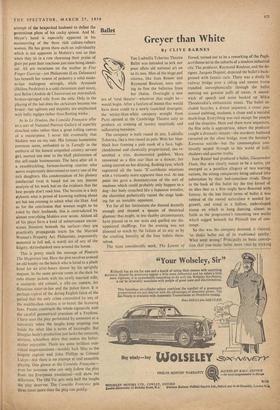Ballet
Greyer than White
By CLIVE BARNES The company is built round its star, Ludmilla Tcherina, like a tent round its pole. With her blue- black hair framing a pale mask of a face, high- cheekboned and classically proportioned, she re- sembled a trim, disinterested goddess. More renowned as a film star than as a dancer, her acting centred on her dilating, flashing eyes, which registered all the basic 'X'-certificate emotions with a virtuosity more apparent than real. At one point she gave a demonstration of the sort of madness which could probably only happen to a dog—her body crouched like a Japanese wrestler, she shambled pathetically round the stage look- ing for an invisible opponent.
Yet for all her limitations she danced decently enough and showed a species of theatrical glamour that might, in less shabby circumstances, have pinned us to our seats and quelled our dis- appointed shufflings. For the evening was not dimmed so much by the failure of its star as by the crushing banality of the four ballets them- selves.
The most considerable work, The Lovers of Teruel, turned out to be a reworking of the Pugh.- acci theme set in the suburbs of a modern industrial city. The producer, Raymond Rouleau, and the de- signer, Jacques Dupont, depicted the ballet's back- ground with fanatic care. There was a dimly lit railway bridge over a siding and unseen trains trundled stereophonically through the ballet snorting out genuine puffs of steam. A sound- track of speech and noise backed up Mikis Theodorakis's enthusiastic music. The ballet in- cluded bicycles, a dream sequence, a crime pas- sionnel stabbing, madness, a chase and a suicidal death-leap. Everything was real except the people and the situation. Here and there were sequences, the film term is appropriate, where the producer caught a dramatic instant—the murderer husband cornered on the silent bridge, even the heroine's Karenina suicide—but the commonplace con- tinually seeped through to this world of half- shadows and quarter-truths.
Jean Renoir had produced a ballet, Gunpowder Flash, that was clearly meant to be a satire, yet emerged as a pointless allegory of two warring nations, the strong conquerors being seduced into submission by their bed-conscious rivals. Deep in the husk of this ballet lay the tiny kernel of an idea that as a film might have flowered with fantasy. In the less literal terms of ballet it was robbed of the rooted naturalism it needed for growth, and stood as a hollow, undeveloped stump on which to hang dancing, almost as futile as the programme's remaining two works which sagged beneath the Plimsoll line of con- tempt.
So this was the company destined, it claimed, `to shake ballet out of its traditional apathy.' What went wrong? Principally its basic concep- tion that you make ballet more vital by tricking it out and handing it over, like slabs of cold Shakespeare, to theatrical producers. The choreo- grapher and producer should ideally be one man, or at least speak with one voice. The choreo- graphers Tcherina selected were, apart from the promising, but inexperienced, Sparemblek, an undistinguished lot, and throughout the dancing remained dull and dead, held back by the well- intentioned efforts of the producers. The result was waste—not the least in the abilities of such dancers as Milko Sparemblek, Vassili Sulich and Stevan Grebel.
Infinitely 'more exciting than the Tcherina follies was the historic Covent Garden per- formance of Coppelia last Saturday afternoon, when the Royal Ballet was banished to the audience, giving over the stage, for the first time, to the students of the Royal Ballet School. Led by three recently graduated junior members of the company—Antoinette Sibley, Graham Usher and Lambert Cox, a young trio of exceptional brilliance—the school danced the complete un- amended ballet with predictable freshness but bewildering skill. The idea of public student per- formances in standard ballets is one known to Moscow but completely new in the West, and it proved a remarkable display of the Royal Ballet's strength and potential, as absolutely unknown kids came on and danced almost like veterans. The Mums and Dads in the audience cheered, the company cheered, even critics cheered, while juniors—still too young for greasepaint—from the school itself screeched out their approval like grubby infants at a rugger match.
THE THEATRE AND ITS DOUBLE. By Antonin Artattd, reviewed recently in the Spectator, is avail- able from John Calder Ltd. at 14s. 6d.







































 Previous page
Previous page